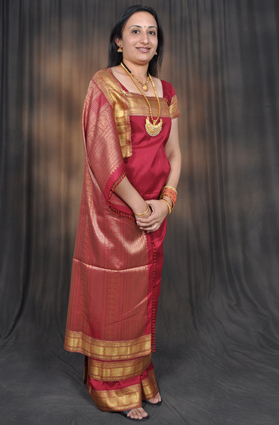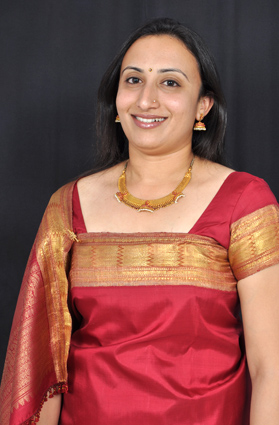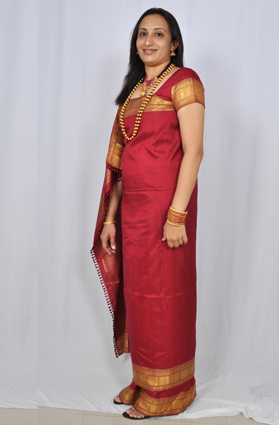
The Coorg style of draping a sari involves tucking the pleats at the back of the waist, instead of the front. The end of the sari is brought below the left shoulder, and secured over the right shoulder in a firm knot called 'molakattu'.
This style suits Coorg women leading an active life while climbing up and down slopes in their mountainous homeland in the Western Ghats. It was believed that the dress helped women clamber up trees when confronted with wild animals in the jungles in the olden days. The fact that women have not taken to change as easily as the costume of the men is concerned stresses on the comfort factor.
The bride is dressed in a red silk sari woven with gold patterned dots, a red silk full-sleeved Coorg blouse (Jacket\Kala Kupya) and a red silk scarf, which is tied around the head.
The corpse of a widow is dressed in clothes without a colored border. The corpse of a married woman on the other hand is dressed in a colored sari with a coloured or gold or silver border. Women mourners wear only white saris and blouses. In addition, close relatives of the deceased, drape a rectangular white cloth on their shoulders, with two of the corners tied in a knot in front. In the past, a Coorg widow wore only white in the case of the sari, blouse and vastra. This is not strictly adhered nowadays which is an indication of the progressive thinking in the Coorg society.
Mythological origin of Coorg sari:
Kavera Muni, a great sage, selected Brahmagiri in Coorg as a place suitable for meditation and there prayed to Lord Brahma for children. Brahma gave him Lopamudra for a daughter. Lopamudra, also known as Kaveri, married sage Agastya on the condition that her husband shall not leave her alone at any time. On one occasion, sage Agastya put his wife in his kamandala (water pot) and went for a bath. Enraged by the betrayal, Kaveri spills out of the pot and flows away as a raging river. Agastya tries to stop her. But Kaveri washes over Coorg women, pleading to stop her flight from their land, with such force, that the pleats of their saris were swept from front to back.
Jacket or Kala Kuppya:
The upper garment below the sari was earlier a white or light blue cotton jacket called Rouka or Kala Kupya with long sleeves and closed up to the neck.
Gradually, the short sleeved, round-necked choli replaced the traditional jacket. There was a considerable amount of change in this garment after the British annexed Coorg in 1834. There were variations in the styling of the neck. The jacket saw the introduction of the high neck and the band collar. The placket was also first seen with the jacket having an opening in the front. The sleeve also became stylish and fitted with an opening at the end with a sleeve placket.

The jacket initially was a shapeless garment only serving the purpose of an upper garment. Following the influence of the British, the stitching patterns changed. What was initially a garment without darts, had darts in front and at the back. Then came the princess seam and also the patch pocket to serve the utilitarian purpose.
The fabrics changed from cotton to silk to experimental fabrics such as satin and velvet which were more often than not imported. The trims also became more fanciful and instead of the usual press buttons, pearl and shell buttons were used.
Musuk (veil):
The Musuk worn by the bride unlike other communities does not cover the face but is just lightly worn over the head. The Musuk in the beginning was of very large dimension and the fabric was usually silk with very ornate motifs and had checks and dots on it. Later, not only did the material change but also became comparatively plain.
The under garment was introduced following the colonial influence as in the case of the chemise. This is a garment of calf length of thin cotton wool depending on the climate and a petticoat falling just above the ankle to add a little volume to the sari.
Vastra (head scarf):
The head was covered with a rectangular length of cloth known as a vastra. This was first tied ceremonially on the eve of the woman's marriage, usually by her mother. One end of the vastra encircles the forehead and the other two corners are joined together at the back, allowing the rest of the cloth to fall elegantly over the back. This served as a symbol of her marital status (as well as a practical protection while working in the fields). The women also wore this while leaving the house and going outdoors. Initially like the other brocaded fabrics this was also woven in Benaras.

Later, the size of the vastra increased probably because the loom no longer existed and the motifs also increased in size and became specific like peacocks and floral baskets and had a large circular motif in the centre, a large border on the four sides. The fabric remained silk. Gradually, the fabric changed to crepes and georgette and became less ornate and the zari was appliquéd on to the fabric. It was further simplified to just a border of sequin work. This was probably a reflection of the fashion influence during that time..
Shift in fashion trends:
With the coming of the British, and photography, there is a very clear shift in fashion trends. Instead of a rustic knot, a fancy brooch secures the sari. The materials also changed drastically and there was an advent of materials such as velvet and satin. Brocade and other luxurious fabrics were used by the well-to-do to make garments. Georgette and other more fashionable fabrics won favour over the more traditional ‘bottu’ saris. Saris were worn with shoes and socks.










